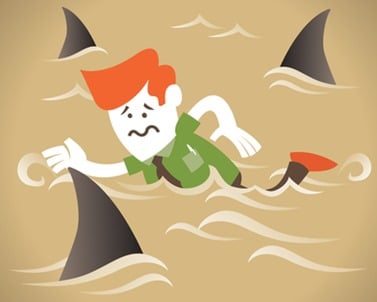Refer also to: The Arse-Covering Myth
Swimming Up Stream and the Safe Work Method Statement Dilemma
 I was with an organisation this week that was being inspected by the regulator. The regulator had the unenviable task of assessing whether this organisation was appropriately managing risk. The regulator generally uses several tools to determine the management of risk: observation, conversation and documentation. It’s pretty easy to see this mob were not an organisation but a dis-organisation. However, organisation in itself does not guarantee professional risk management.
I was with an organisation this week that was being inspected by the regulator. The regulator had the unenviable task of assessing whether this organisation was appropriately managing risk. The regulator generally uses several tools to determine the management of risk: observation, conversation and documentation. It’s pretty easy to see this mob were not an organisation but a dis-organisation. However, organisation in itself does not guarantee professional risk management.
Conversation is an excellent tool for assessing culture and the psychology of risk but you have to know what you are listening for. Unfortunately, the psychology of risk is not the core business of regulators and so I can’t imagine them being skilled enough to use this tool well. The conversation tool relies on skilled knowledge of pitching, framing and priming language. Understanding cultural discourse is much more complex than doing some HR communications course. Listening and ‘speaking into’ cultural discourse requires a sophisticated knowledge of human mentalitie. This is not a spelling mistake but indicates a special understanding of the mental equipment humans use to make judgments and decisions (from Annales School and Lucien Le Febre). Skilled conversations about risk culture doesn’t come without some coaching and study. Most people know that if your tell the regulator what they want to hear then you will pass the inspection.
This leaves the final tool and this is where the dilemma really intensifies. The primary tool for evidence in managing risk for the regulator is documentation. Documentation is wonderful evidence in court, although photos are pretty good too. The primary tool of documentation for the regulator is the Safe Work Method Statement or SWMS (pronounced ‘swims’). Some industries call this document a Job Safety and Environment Analysis (JSEA). SWMS are intended to serve as a front line tool for the documentation of thinking about risk and hazards at each stage of work and the controls used to minimize risk at each stage.
SWMS have now become an industry in themselves. I know several large projects which have more than 2500 SWMS for every conceivable activity on site. The organisation I started this discussion with failed on their SWMS because the format wasn’t right? It’s now got to the stage in some industries where SWMS are completed for the most trivial activities. Some industries, unions and regulators are so paranoid about SWMS today that they have become the new Bible for risk management.
Here’s the dilemma. Most SWMS are completed by professionals, trained safety officers and office-based people who have a certain level of bureaucratic literacy. Many organisations construct their SWMS by copy and paste from successful SWMS from other organisations. They then tweak it a bit, see if it gets over the line and then edit until it is passed by the regulator. Once this is done everyone on site sign on to the SWMS, the classic example of ‘tick and flick’. No-one other than the official really digests or comprehends the SWMS because some are in excess of 30 pages for even quite simple activities. Of course the assessment and management of risk requires high levels of imagination and creativity, the very qualities which are generally absent in bureaucratic mentalities but present in worker mentalities. So the people preparing the SWMS are constrained in their creativity about risk in the SWMS and besides, the regulator doesn’t want imagination anyway, just conformance to acceptable type and style. Many SWMS processes between a company and regulator remind me much more of a Primary school teacher correcting a grade 6 project than a purpose driven safety tool!
Most people ‘on the tools’ have low levels of bureaucratic literacy and just want to ‘get the job done’ so they sign it off believing it is simply and ’arse coving exercise.’ Results for the MiProfile Survey show that 75% of all workers believe this is the fundamental purpose of SWMS.
The real dilemma with SWMS concerns the gap between ‘projected risk’ and ‘attributed risk’ in the SWMS and ‘actual’ or ‘real risk’ in the field. Whilst the SWMS are intended to be a safety thinking tool, this is not how they are used. They are used more and more as an end in themselves and are quickly becoming meaningless in the battle against reckless risk taking behaviour in the workplace.



Do you have any thoughts? Please share them below